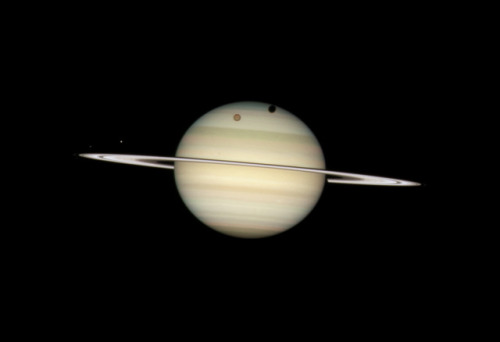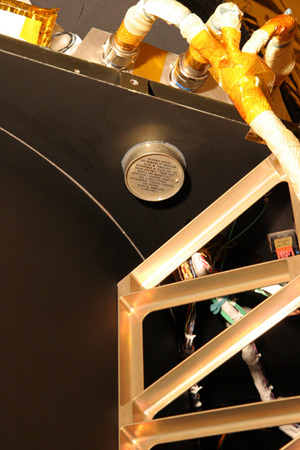Celebrating Five Years At Jupiter!
Celebrating Five Years at Jupiter!
We just released new eye-catching posters and backgrounds to celebrate the five-year anniversary of Juno’s orbit insertion at Jupiter in psychedelic style.

On July 4, 2016, our Juno spacecraft arrived at Jupiter on a mission to peer through the gas giant planet’s dense clouds and answer questions about the origins of our solar system. Since its arrival, Juno has provided scientists a treasure trove of data about the planet’s origins, interior structures, atmosphere, and magnetosphere.

Juno is the first mission to observe Jupiter’s deep atmosphere and interior, and will continue to delight with dazzling views of the planet’s colorful clouds and Galilean moons. As it circles Jupiter, Juno provides critical knowledge for understanding the formation of our own solar system, the Jovian system, and the role giant planets play in putting together planetary systems elsewhere.
Get the posters and backgrounds here!
For more on our Juno mission at Jupiter, follow NASA Solar System on Twitter and Facebook.
Make sure to follow us on Tumblr for your regular dose of space!
More Posts from Sergioballester-blog and Others
One Step Closer to the Moon with the Artemis Program! 🌙

The past couple of weeks have been packed with milestones for our Artemis program — the program that will land the first woman and the next man on the Moon!

Artemis I will be an integrated, uncrewed test of the Orion spacecraft and Space Launch System (SLS) rocket before we send crewed flights to the Moon.

On March 2, 2021, we completed stacking the twin SLS solid rocket boosters for the Artemis I mission. Over several weeks, workers with NASA's Exploration Ground Systems used one of five massive cranes to place 10 booster segments and nose assemblies on the mobile launcher inside the Vehicle Assembly Building at the Kennedy Space Center (KSC) in Florida.
On March 18, 2021, we completed our Green Run hot fire test for the SLS core stage at Stennis Space Center in Mississippi. The core stage includes the flight computers, four RS-25 engines, and enormous propellant tanks that hold more than 700,000 gallons of super cold propellant. The test successfully ignited the core stage and produced 1.6 million pounds of thrust. The next time the core stage lights up will be when Artemis I launches on its mission to the Moon!

In coming days, engineers will examine the data and determine if the stage is ready to be refurbished, prepared for shipment, and delivered to KSC where it will be integrated with the twin solid rocket boosters and the other rocket elements.
We are a couple steps closer to landing boots on the Moon!
Make sure to follow us on Tumblr for your regular dose of space: http://nasa.tumblr.com

Discovery Shuttle docked to the ISS. 🌎🚀

Charon, moon of Pluto, observed by NASA’s New Horizons probe on this day in 2015.

Welcome to Mars, Percy!
February 18, 2021 - @nasa successfully landed its new robotic rover ‘Perseverance’ on Mars, a mission to directly study if there was ever life on the planet.

Saturn With Quadruple Moon Presence – Hubble Telescope

Montage of Neptune and Triton by NASA on The Commons

July 20, 1969
Project Apollo on Flickr

The Moon with the ISS transitioning in front of it. Amazing view considering the ISS moves over and past it in a matter of seconds.
Going the Distance... In Space
On April 17, NASA's New Horizons crossed a rare deep-space milestone – 50 astronomical units from the Sun, or 50 times farther from the Sun than Earth is. New Horizons is just the fifth spacecraft to reach this great distance, following the legendary Voyagers 1 and 2 and Pioneers 10 and 11. It’s almost 5 billion miles (7.5 billion kilometers) away; a remote region where a signal radioed from NASA's largest antennas on Earth, even traveling at the speed of light, needs seven hours to reach the far-flung spacecraft.
To celebrate reaching 50 AU, the New Horizons team compiled a list of 50 facts about the mission. Here are just a few of them; you'll find the full collection at: http://pluto.jhuapl.edu/News-Center/Fifty-Facts.php.

New Horizons is the first – and so far, only – spacecraft to visit Pluto. New Horizons sped through the Pluto system on July 14, 2015, providing a history-making close-up view of the dwarf planet and its family of five moons.
New Horizons is carrying some of the ashes of Pluto’s discoverer, Clyde Tombaugh. In 1930, the amateur astronomer spotted Pluto in a series of telescope images at Lowell Observatory in Arizona, making him the first American to discover a planet.

The “Pluto Not Yet Explored” U.S. stamp that New Horizons carries holds the Guinness World Record for the farthest traveled postage stamp. The stamp was part of a series created in 1991, when Pluto was the last unexplored planet in the solar system.

Dispatched at 36,400 miles per hour (58, 500 kilometers per hour) on January 19, 2006, New Horizons is still the fastest human-made object ever launched from Earth.
As the spacecraft flew by Jupiter’s moon Io, in February 2007, New Horizons captured the first detailed movie of a volcano erupting anywhere in the solar system except Earth.

New Horizons’ radioisotope thermoelectric generator (RTG) – its nuclear battery – will provide enough power to keep the spacecraft operating until the late-2030s.

Measurements of the universe’s darkness using New Horizons data found that the universe is twice as bright as predicted – a major extragalactic astronomy discovery!

New Horizons’ Venetia Burney Student Dust Counter is the first student-built instrument on any NASA planetary mission – and is providing unprecedented insight into the dust environment in the outer solar system.

New Horizons is so far away, that even the positons of the stars look different than what we see from Earth. This view of an "alien sky" allowed scientists to make stereo images of the nearest stars against the background of the galaxy.

Arrokoth – the official name the mission team proposed for the Kuiper Belt object New Horizons explored in January 2019 – is a Native American term that means “sky” in the Powhatan/Algonquin language.

Stay tuned in to the latest New Horizons updates on the mission website and follow NASA Solar System on Twitter and Facebook.
Make sure to follow us on Tumblr for your regular dose of space: http://nasa.tumblr.com.
-
 apolloexe liked this · 1 month ago
apolloexe liked this · 1 month ago -
 pluviophiles-and-melomanie liked this · 8 months ago
pluviophiles-and-melomanie liked this · 8 months ago -
 elhuronyyo liked this · 10 months ago
elhuronyyo liked this · 10 months ago -
 iknowaladygoodandevil liked this · 11 months ago
iknowaladygoodandevil liked this · 11 months ago -
 pemifolpe liked this · 1 year ago
pemifolpe liked this · 1 year ago -
 dotglobal liked this · 2 years ago
dotglobal liked this · 2 years ago -
 bluniper000 liked this · 2 years ago
bluniper000 liked this · 2 years ago -
 mrm7moud liked this · 2 years ago
mrm7moud liked this · 2 years ago -
 sunnydaysinamusicalhaze reblogged this · 3 years ago
sunnydaysinamusicalhaze reblogged this · 3 years ago -
 appla1 reblogged this · 3 years ago
appla1 reblogged this · 3 years ago -
 dudeyoushould liked this · 3 years ago
dudeyoushould liked this · 3 years ago -
 xxgrasstastesbadxx reblogged this · 3 years ago
xxgrasstastesbadxx reblogged this · 3 years ago -
 underw18er liked this · 3 years ago
underw18er liked this · 3 years ago -
 bellaari liked this · 3 years ago
bellaari liked this · 3 years ago -
 mermaidonsororityrow liked this · 3 years ago
mermaidonsororityrow liked this · 3 years ago -
 chelsychacon liked this · 3 years ago
chelsychacon liked this · 3 years ago -
 sunnydaysinamusicalhaze liked this · 3 years ago
sunnydaysinamusicalhaze liked this · 3 years ago -
 apocalypsxdreams liked this · 3 years ago
apocalypsxdreams liked this · 3 years ago -
 fancyengineerwolf liked this · 3 years ago
fancyengineerwolf liked this · 3 years ago -
 almostvblue liked this · 3 years ago
almostvblue liked this · 3 years ago -
 pinuspalustris reblogged this · 3 years ago
pinuspalustris reblogged this · 3 years ago -
 cobbled-vibrance liked this · 3 years ago
cobbled-vibrance liked this · 3 years ago -
 slylevi liked this · 3 years ago
slylevi liked this · 3 years ago -
 cybernatedangel liked this · 3 years ago
cybernatedangel liked this · 3 years ago -
 saltythexfilesindianjonescop liked this · 3 years ago
saltythexfilesindianjonescop liked this · 3 years ago -
 thenewwavenyc reblogged this · 3 years ago
thenewwavenyc reblogged this · 3 years ago -
 magpies-marble liked this · 3 years ago
magpies-marble liked this · 3 years ago -
 rouse-modio liked this · 3 years ago
rouse-modio liked this · 3 years ago -
 catyuy reblogged this · 3 years ago
catyuy reblogged this · 3 years ago -
 swimmingharmonykryptonite reblogged this · 3 years ago
swimmingharmonykryptonite reblogged this · 3 years ago -
 swimmingharmonykryptonite liked this · 3 years ago
swimmingharmonykryptonite liked this · 3 years ago -
 stardust-wonder liked this · 3 years ago
stardust-wonder liked this · 3 years ago -
 ohhhhnanaa liked this · 3 years ago
ohhhhnanaa liked this · 3 years ago